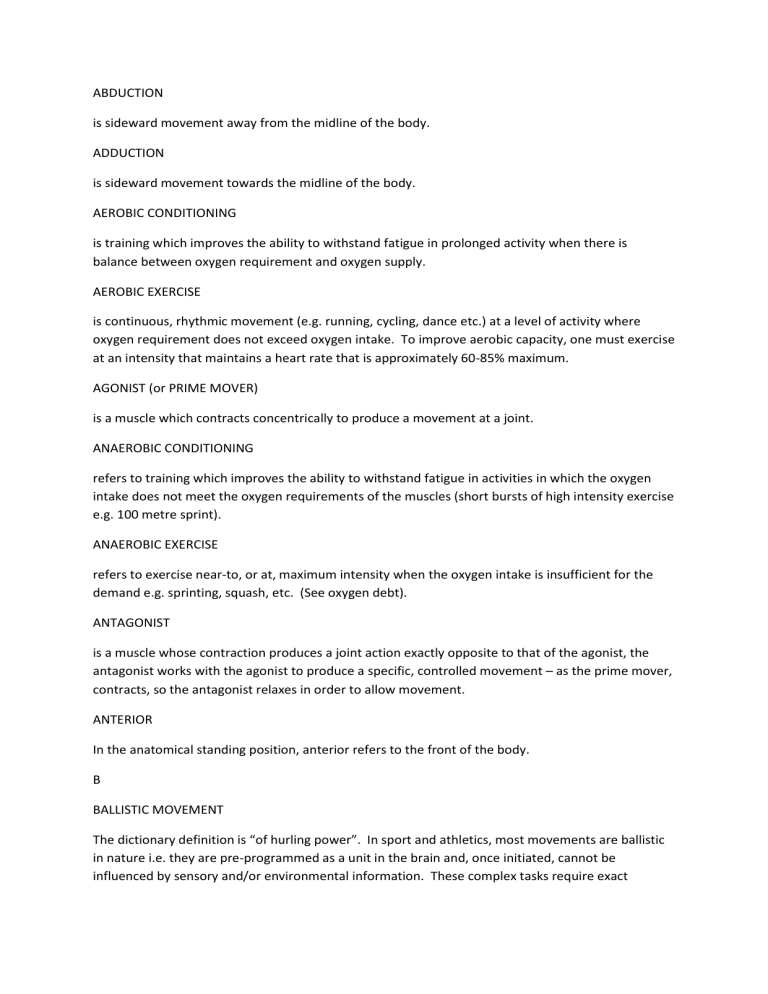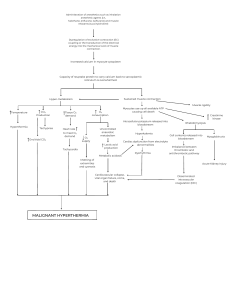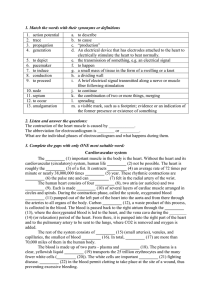
ABDUCTION is sideward movement away from the midline of the body. ADDUCTION is sideward movement towards the midline of the body. AEROBIC CONDITIONING is training which improves the ability to withstand fatigue in prolonged activity when there is balance between oxygen requirement and oxygen supply. AEROBIC EXERCISE is continuous, rhythmic movement (e.g. running, cycling, dance etc.) at a level of activity where oxygen requirement does not exceed oxygen intake. To improve aerobic capacity, one must exercise at an intensity that maintains a heart rate that is approximately 60-85% maximum. AGONIST (or PRIME MOVER) is a muscle which contracts concentrically to produce a movement at a joint. ANAEROBIC CONDITIONING refers to training which improves the ability to withstand fatigue in activities in which the oxygen intake does not meet the oxygen requirements of the muscles (short bursts of high intensity exercise e.g. 100 metre sprint). ANAEROBIC EXERCISE refers to exercise near-to, or at, maximum intensity when the oxygen intake is insufficient for the demand e.g. sprinting, squash, etc. (See oxygen debt). ANTAGONIST is a muscle whose contraction produces a joint action exactly opposite to that of the agonist, the antagonist works with the agonist to produce a specific, controlled movement – as the prime mover, contracts, so the antagonist relaxes in order to allow movement. ANTERIOR In the anatomical standing position, anterior refers to the front of the body. B BALLISTIC MOVEMENT The dictionary definition is “of hurling power”. In sport and athletics, most movements are ballistic in nature i.e. they are pre-programmed as a unit in the brain and, once initiated, cannot be influenced by sensory and/or environmental information. These complex tasks require exact precision in the timing and co-ordination of both the muscle contraction and the sequence of muscular activity required. BLOOD PRESSURE is defined by two values: (a) systolic pressure which is the pressure in the arteries with each contraction, and (b) diastolic pressure which is the pressure in the arteries as the heart rests between beats. (See also HYPERTENSION). C CALORIE (cal) the amount of heat required to raise the temperature of 1 gram of water to 1ºC. CARDIOVASUCLAR FITNESS refers to the combined efficiency of blood vessels, heart and lungs. It determines the ability of an individual to continue physical exercise for prolonged periods. CIRCUIT TRAINING 8 – 10 exercise stations at which different exercises are performed for a prescribed duration, frequency and intensity. CIRCUMDUCTION is the movement of a limb as it describes the boundary of a cone, combining elements of flexion, abduction and adduction (e.g. freestyle swimming). CONCENTRIC CONTRACTION is a muscular contraction which causes the origin and insertion of a muscle to move towards each other. CONDITIONED INDIVIDUAL (PHYSICALLY FIT) refers to a person who exercises at an intensity of greater than 8 METS for a duration greater than 30 minutes, at a frequency of 3 or more times a week. CONDITIONING (OR TRAINING) Conditioning is the process by which specific structures of the body (skeletal muscle fibres, heart muscle, blood vessels, red blood cells, etc)adapt in response to the increase in regular physical activity. These adaptations enable the individual to perform at a given exercise intensity with greater ease or for a longer duration, to exercise at a higher intensity for a given period of time, and to perform at a greater maximum intensity. CONDITIONING PROGRAMMES may use continuous exercise (e.g. cross-country running), circuit training, interval training, etc., or a combination of these methods. D DIAGNOSTIC EXERCISE TEST a multistage graded exercise test on a bicycle ergometer or treadmill. ECG and blood pressure are monitored and the test, administered for the purpose of producing evidence of ischaemic changes in the ECG recording, is under the direct supervision of a physician. DISTAL when describing any point of reference (distance), distal is the point furthest from the trunk. DORSAL refers to the top part e.g. the top of the foot. DORSIFLEXION refers to movement at the ankle joint that brings the toes towards the shin. E ECCENTRIC CONTRACTION is the contraction of a muscle as the origin and the insertion move away from each other. EVERSION occurs when the sole of the foot moves outward. EXTENSION is movement which increases the angle at a joint or straightens a joint (opposite to FLEXION). F FATIGUE occurs when an individual is unable to continue an exercise because of a decrease in either the force or the frequency of muscle contraction. During walking, running or cycling fatigue is said to occur when the individual cannot maintain the desired speed, with weight-lifting, the fatigue is said to occur when consecutive lifts of a given weight can no longer be maintained. FIELD TEST This consists of walking, walking/running, or running for a period of approximately 15 minutes at the highest comfortable intensity the participant can maintain. The field test may take place on level, firm terrain, on a track, a treadmill, bicycle ergometer or steps. Functional capacity of the participant may be estimated as follows: Walking: METS equals the average speed in miles per hour. Running: MET equals 1.5 times the average speed in miles per hour. FLEXION refers to movement at a joint which decreases the angle at the joint, or bends a joint. (Opposite to EXTENSION). FREE WEIGHTS are any weights which are not attached to a machine e.g. barbells, dumbbells, etc. FUNCTIONAL CAPACITY expressed in METS, refers to the average exercise intensity performed during a 15 minute field test, or the maximum exercise intensity achieved during a graded exercise test performed on a bicycle ergometer or a treadmill. G GRADED EXERCISE TEST is designed on an individual basis to meet the diagnostic requirements of the test administrator, and to comply with functional capacity and health of the participant. The test may be administered using either a continuous or discontinuous protocol on a cycle ergometer or a treadmill. The exercise should begin at a low intensity, usually 2-4 METS, and then increase in even 1-3 METS increments until termination due either to voluntary fatigue or development of contra-indicatory signs or symptoms. H HEALTHY INDIVIDUAL is one who is asymptomatic, has no known pathology and no known risk factors greater than the population norms for the individual’s sex and age. HEART RATE refers to the number of heart beats per minute (bpm). Actual maximal heart rate is largely genetically-determined and is not necessarily related to state of health or fitness. It is also highly dependent on age, but an approximate average maximal heart rate for any group can be obtained using the formula (220-age). Average resting heart rate is taken to be around 70 bpm, but this also varies according to age, fitness level etc. The rate of decrease in heart rate following a training programme provides an index of the degree of cardiovascular fitness. Highly conditioned endurance athletes could have a resting heart rate of below 40 bpm, whereas sedentary out-of-condition adults could have a heart rate in the region of 100 bpm HYPERABDUCITON refers to the upper arm when it is abducted beyond the vertical, as seen from the front or back. HYPERADDUCTION Usually the trunk blocks hyperadduction in the upper and lower extremities. However, by combining slight flexion and hyperadduction, the upper extremities can move across in front of the body. HYPEREXTENSION refers to extension of a joint past its normal position of extension. HYPERTENSION OR HIGH BLOOD PRESSURE is defined as a systolic blood pressure (SBP) of 160 mmHg or higher, and/or a diastolic blood perssure (DBP) of 95 mmHg or higher. I INFERIOR describes the lower surface of an organ or muscle i.e. the superior part lies above the inferior part. INTERVAL TRAINING e.g. short runs with intervals of rest in between. INVERSION refers to movement of the sole of the foot inwards. ISOKINETIC CONTRACTION is contraction in which maximal force is exerted on the muscle throughout the entire range of movement. Isokinetic means “same speed” and isokinetic exercises control the speed of the movement. ISOMETRIC CONTRACTION is contraction of a muscle when there is no movement of joint or change in the length of the muscle. Isometric means “same distance”, and isometric exercises make use of resistive forces e.g. pressing against a door frame/floor, etc. ISOTONIC CONTRACTION is the contraction of a muscle which involves a change in the length of the muscle. Isotonic means “same tension”, and during isotonic exercises motion occurs at a joint/joints. K KILOCALORIE (kCal or Cal) – the amount of heat required to raise the temperature of 1000g.water 1ºC. The kCal is the unit of measurement applied to food energy. L LATERAL is the side that is furthest from the midline axis i.e. refers to the outside of the body or body segment. LATERAL FLEXION refers to the lateral bending of the head or trunk. It may also be used for sideward movements of the middle finger, although usually the more specific terms of radial and ulnar flexion are used. LINEA ALBA is a band of connective tissue extending from the xiphoid process to the symphasis pubis. M MAXIMAL OXYGEN UPTAKE (VO2MAX) represents the estimate of cardiovascular and respiratory efficiency and capacity. Every cell in the body requires oxygen to function properly. As muscular activity increases, so the oxygen demand of the working muscles increases proportionately, but everyone has a finite limit to the quantity of oxygen which can be delivered to the muscles during exercise. The upper limit is referred to as the maximal oxygen uptake, and since it is largely genetically determined, it is only minimally increased by training (10-15%). Theoretically, the higher the VO2 max, the better the efficiency of the lungs, heart and vascular system and the greater the potential for success in endurance activities. MEDIAL Point of reference close to the midline of the body. MET refers to working metabolic rate divided by the resting metabolic rate, and therefore represents the multiples of the resting metabolic rate required for a given activity. The resting metabolic rate is equal to 1 MET, thus a 3MET activity requires 3 times more energy than that used at rest. MUSCLE ENDURANCE refers to the ability of a muscle or muscle group to sustain effort for prolonged periods. MUSCLE STRENGTH is the maximum amount of force which may be exerted by a muscle or muscle group against resistance. O OUTWARD OR INWARD ROTATION apply respectively to outward (lateral) and inward (medial) rotation of the forearm. OVERLOAD PRINCIPLE requires a muscle to perform at a level which is greater than its present capacity. Progressively higher loads (or tasks) are required of the muscle (or system) to force it to develop further. (Mainly used in weight-training). P PLANTAR refers to the bottom i.e. underneath the foot. POSTERIOR In the anatomical standing position, posterior is the non-facing side (i.e. back view). PRONATION OF THE FOOT This is when the ankle is dorsiflexed and the subtalar joint everted causing the foot and ankle to roll inward. PRONATION OF THE HAND implies the palm is facing backward or downward. PRONE the body is lying face down. PROXIMAL when describing any point of reference (distance), proximal is the point closest to the body. R REDUCTION OF HYPERADDUCTION/HYPERABDUCTION Return movement from hyperadduciton/abduction. REDUCTION OF LATERAL FLEXION Return movement from lateral flexion. REDUCTION OF OUTWARD ROTATION, INWARD ROTATION, SUPINATION OR PRONATION Rotation of the segment back to the midposition. (The point of reference for all rotation or the upper extremities is the midposition as in the fundamental (not anatomic) standing position). ROTATION LEFT AND RIGHT is applied to rotation of the head or neck in such a way that the anterior aspect turns respectively to the left or to the right. S SUPERIOR describes the upper surface of an organ or muscle. SUPINATION OF THE FOOT This is when there is a simultaneous combination of plantar flexion of the ankle and inversion of the subtalar articulations causing the foot and ankle to roll outward. SUPINATION OF THE HAND implies the palm is facing forward or upward. SUPINE The body is lying face up. V VO2 MAX Refer to LATERAL FLEXION



